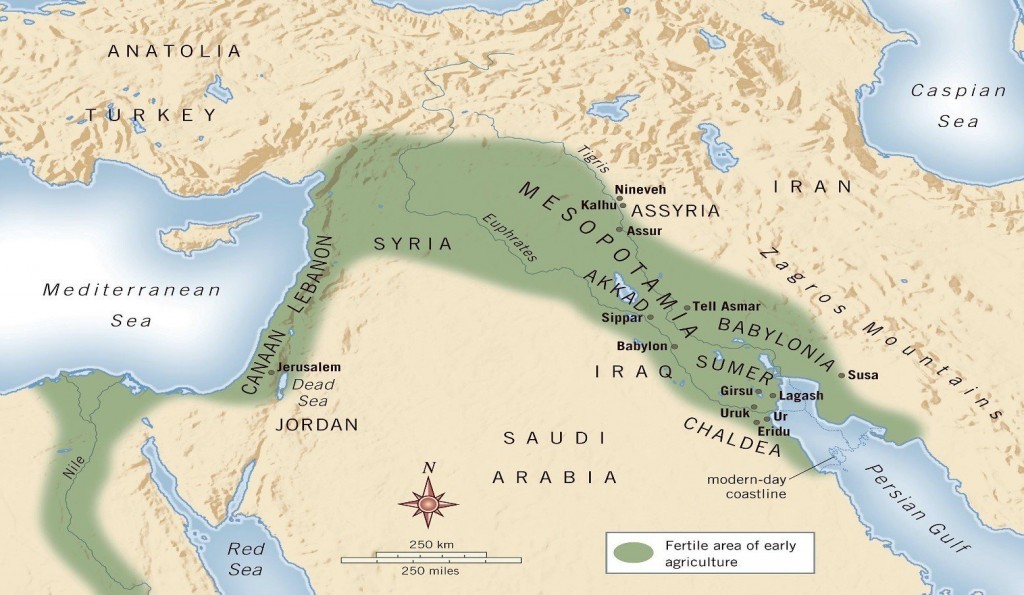If I showed you the map attached to this article, and asked you to point out to me where the Sumerians lived and who were they, (I’m sure you could, because it’s mentioned on the map), or where the Fertile Crescent is and what is it, would you be able to answer any of the questions? Before the end of this article, I hope you can answer all those questions!

We all know the story about the Great Flood. Save eight faithful men and woman, the entire population was wiped out, leaving the eight to repopulate the earth. A few years later they decided to construct “a city, and a tower whose top will reach into heaven” (Genesis 11:4). Doing so caused the LORD to confuse their language scattering them all abroad, causing them to spread across the whole earth. Soon after, the earliest civilization is recorded, the Sumerians, who lived in Sumer. If you look on the map, you can see right by the Persian Gulf, the land of Sumer!
Sumer is located in the Fertile Crescent, and more specific, in Mesopotamia. If you’ve never heard of the Fertile Crescent, it is the section of the map looking like a green crescent roll. Stretching from the Persian Gulf, all the way down to Egypt. The Fertile Crescent is the only section capable of producing any kind of vegetation. If you lived in Sumer and you were trying to get to Egypt, you would not do so by crossing the desert for obvious reasons, you would die not even half way through Saudi Arabia. You would take route taking you through the land full of life, vegetation, and water.
The Sumerians were an incredibly intelligent civilization. After the flood, many of man’s skills and crafts would have been lost, but they show that men were never bumbling cavemen. They were more advanced in their way of life than most countries are today. They had irrigation systems, working toilets, some homes even had the luxury of hot and cold water. But they are best known for their written language named ‘cuneiform’.
It is believed that civilizations who had a written language copied and put their own twist on cuneiform. Cuneiform is made up of 600 symbols that represents sounds, written in a tablet of clay by a wedge made of reed. The created schools just to learn how to write cuneiform. Can you imagine learning 600 different symbols?
They also were very skilled in architecture, they built a structure called a Ziggurat. They were used to worship their gods, seeing as religion was very, very important to them. They would be buried with their treasures, and in their best clothes, because they thought they needed them for the unknown afterlife. And when the building would either fall apart, or be destroyed by war, they would simply rebuild on top of the wreckage!
Now, we have read very often about one of the inhabitants of Mesopotamia. In Ur, right on the edge of the Persian Gulf, lived an extremely wealthy man name Abram. Knowing what you know about Mesopotamia, and the Sumerians, think about what Abram had! He was probably one of the people who had the luxurious hot and cold water, and a flushing toilet. Think about how hard it would have been to leave Mesopotamia, but he left without so much as ‘but LORD. . .’, because he had complete faith in God. That’s a lesson we all need to learn.
*Mystery of History Volume 1; Linda Lacour Hobar 2002, The Sumerians, page 27.
- Learning History as His Story: The Fertile Crescent - February 28, 2016
- Learning History as His Story: Earth at the Time of Creation - January 7, 2016

 Welcome! We are so glad you stopped by. Come Fill Your Cup is a group of Christian ladies dedicated to equipping women for study and service. We know you are busy and that life’s hectic pace pulls you in so many directions, but you can’t truly be the woman God desires unless you take time to fill your own cup…not with spa days (though we love a good spa!) or the latest novel…but with God’s Holy Word. We want to help you with that! Our goal is to reach you in the midst of your busy day and give you encouragement, education, and fellowship as you strive to live the life God has laid before you. Our prayer is that we can help fill your cup so that you, in turn, can overflow to all those around you. So, as we like to say…come fill your cup, and let it overflow!
Welcome! We are so glad you stopped by. Come Fill Your Cup is a group of Christian ladies dedicated to equipping women for study and service. We know you are busy and that life’s hectic pace pulls you in so many directions, but you can’t truly be the woman God desires unless you take time to fill your own cup…not with spa days (though we love a good spa!) or the latest novel…but with God’s Holy Word. We want to help you with that! Our goal is to reach you in the midst of your busy day and give you encouragement, education, and fellowship as you strive to live the life God has laid before you. Our prayer is that we can help fill your cup so that you, in turn, can overflow to all those around you. So, as we like to say…come fill your cup, and let it overflow!
Leave a Reply